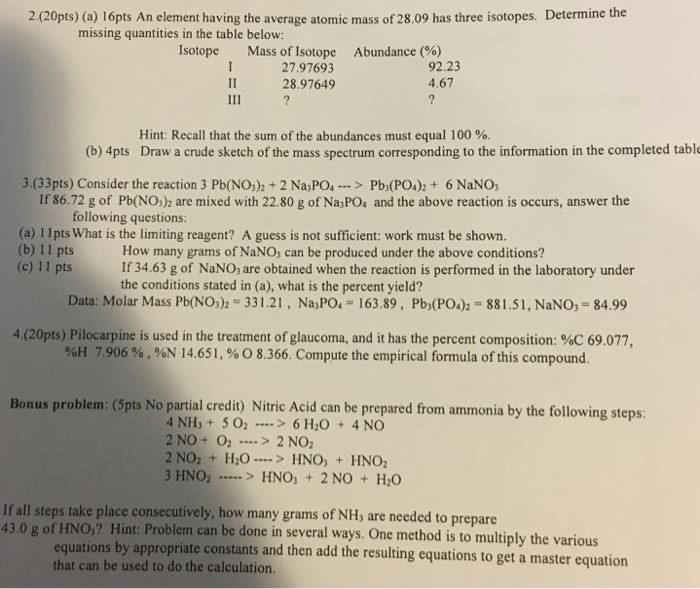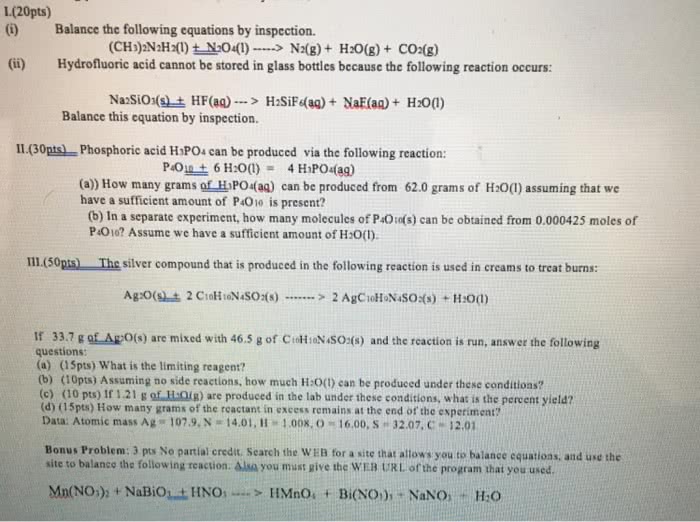CHEM 2031 Lecture Notes - Lecture 7: Composition C, Reagent, Stoichiometry

Lecture 7: September 13, 2017
• Problem 2 (Ex. 3.3)
• Mass of Oxygen in 1.3 kg Ca3(PO4)2
Ca3(PO4)2 = 310.18 g/mol
%O = (8 x 16.00 g)/(310.18 g) x 100% = 41.27%
3.9 Determining Chemical Formulas by Experiment
• Copy flow chart
• Combustion Analysis —> Mass % Composition
• CxHyOz + O2 —> CO2 +H2O
• Mass % composition —> empirical formula
• 1. assume 100g/compound
• 2. grams of each event from mass % comp
• 3. grams of element to moles of element
• 4. simplest who number mole ratio of elements
• 5. empirical formula
Ex. 3.4: ascorbic acid (vitamin C) is 40.92% C, 4.58% H, 54.50% O. what’s the
empirical formula and molar formula if molar mass is 176 g/mol.
100 g ascorbic acid: 40.92 g C, 4.58 g H, 54.50 g O
40.92g C x (1 mol C)/(12.01 g C)
3.10 Writing and Balancing Chemical Equations
• R —> P in chemical symbols/formulas
1. Write formulas and indicate states
Ex. ethane + oxygen —> C2H6(g) + O2(g)
2. Change coefficients to balance atoms of each element (don’t change subscript)
Ex. 2CO2 NOT (CO2)2
Start by balancing the elements that appear in only on reactant/product
Ex. 2C2H6(g) + 7O2(g) —> 4CO2(g) + 6H2O(l)
Lecture 7: September 18, 2017
Another Approach to Find the Limiting Reagent
• aA + bB --> cC +dD
• (moles of A given)/a —> x
• (moles of B given)/b —> y
• The limiting reagent goes with the smaller of x and y
• Theoretical Yield: the amount calculated from reaction stoichiometry using the limiting
reagent
• Actual Yield: amount actually obtains
• % Yield = (actual yield)/(theoretical yield) x 100% < 100%
• % yield is normally < 100% because…
Lose to side reactions
Loss to reaction work-up
4.4 Solution Stoichiometry
find more resources at oneclass.com
find more resources at oneclass.com
Document Summary
Lecture 7: september 13, 2017: problem 2 (ex. %o = (8 x 16. 00 g)/(310. 18 g) x 100% = 41. 27% 3. 4: ascorbic acid (vitamin c) is 40. 92% c, 4. 58% h, 54. 50% o. what"s the empirical formula and molar formula if molar mass is 176 g/mol. 100 g ascorbic acid: 40. 92 g c, 4. 58 g h, 54. 50 g o. 40. 92g c x (1 mol c)/(12. 01 g c) 3. 10 writing and balancing chemical equations: r > p in chemical symbols/formulas, write formulas and indicate states. Ex. ethane + oxygen > c2h6(g) + o2(g: change coefficients to balance atoms of each element (don"t change subscript) Start by balancing the elements that appear in only on reactant/product. 2c2h6(g) + 7o2(g) > 4co2(g) + 6h2o(l) aa + bb --> cc +dd. Another approach to find the limiting reagent: theoretical yield: the amount calculated from reaction stoichiometry using the limiting (moles of a given)/a > x (moles of b given)/b > y.




